Caracterización varietal de líneas promisorias de arveja (Pisum sativum L.) de la cruza de Utrillo x Usui, en La Molina
Loading...
Código QR
Authors
Menor Bustamante, María Yanita
Contact Email
Abstract
La investigación se realizó en el Programa de Investigación y Proyección Social en Leguminosas de Grano y Oleaginosas (PLGO) de la Universidad Agraria La Molina (UNALM) durante el período comprendido entre junio y octubre del año 2022 con el objetivo fue caracterizar morfológicamente líneas promisorias F9 de arveja, provenientes de la cruza de los parentales Utrillo x Usui, y evaluar el rendimiento en grano verde y en grano seco. Se empleó un diseño de bloques completamente al azar (DBCA) con seis tratamientos y tres repeticiones. Las líneas evaluadas mostraron características favorables, como crecimiento indeterminado y textura rugosa, ideales para consumo en grano verde. En precocidad, destacaron las líneas L2 (101.0 días), L3 (104.7 días) y L4 (105.7 días). En calidad de grano, sobresalieron L3 con 7.9 °Brix en sólidos solubles y L2 con 24.2 % en sólidos totales. Además, la línea L4 y el parental Usui obtuvieron la mayor cantidad de ramificaciones (3.7 y 3.3 ramas), mientras que la línea L3 y el parental Utrillo presentaron la primera vaina en el 11.3vo y 12.5vo nudos, respectivamente. Las líneas, L2, L3 y el parental Utrillo alcanzaron un rendimiento de 10 t/ha en grano verde y se apreció que el peso de vaina por planta y el número de granos por vaina influyeron positivamente en el rendimiento. No hubo significancia estadística para el rendimiento en grano seco; sin embargo, el peso de vainas por planta y el peso de cien granos condicionaron favorablemente en el rendimiento. El estudio demostró el potencial de las líneas promisorias para mejorar la productividad del cultivo, integrando la precocidad de Utrillo y la resistencia a factores adversos de Usui, posicionándolas como una alternativa viable para los agricultores peruanos.
The research was carried out in the Grain and Oilseed Legumes Research and Social Projection Program (PLGO) of the La Molina Agrarian University (UNALM) during the period between June and October 2022 with the objective of morphologically characterizing promising F9 pea lines, coming from the crossing of the Utrillo x Usui parents, and evaluating the yield in green grain and dry grain. A completely randomized block design (DBCA) with six treatments and three replications was used. The evaluated lines showed favorable characteristics, such as indeterminate growth and rough texture, ideal for consumption as green grain. In terms of precocity, the lines L2 (101.0 days), L3 (104.7 days) and L4 (105.7 days) stood out. In terms of grain quality, L3 stood out with 7.9 °Brix in soluble solids and L2 with 24.2 % in total solids. In addition, the L4 line and the Usui parent obtained the greatest number of branches (3.7 and 3.3 branches), while the L3 line and the Utrillo parent presented the first pod at the 11.3 and 12.5 nodes, respectively. The lines, L2, L3 and the parent Utrillo, reached a yield of 10 t/ha in green grain and it was observed that the weight of pod per plant and the number of grains per pod positively influenced the yield. There was no statistical significance for the dry grain yield; however, the weight of pods per plant and the weight of one hundred grains had a favorable effect on the yield. The study demonstrated the potential of the promising lines to improve crop productivity, integrating the precocity of Utrillo and the resistance to adverse factors of Usui, positioning them as a viable alternative for Peruvian farmers.
The research was carried out in the Grain and Oilseed Legumes Research and Social Projection Program (PLGO) of the La Molina Agrarian University (UNALM) during the period between June and October 2022 with the objective of morphologically characterizing promising F9 pea lines, coming from the crossing of the Utrillo x Usui parents, and evaluating the yield in green grain and dry grain. A completely randomized block design (DBCA) with six treatments and three replications was used. The evaluated lines showed favorable characteristics, such as indeterminate growth and rough texture, ideal for consumption as green grain. In terms of precocity, the lines L2 (101.0 days), L3 (104.7 days) and L4 (105.7 days) stood out. In terms of grain quality, L3 stood out with 7.9 °Brix in soluble solids and L2 with 24.2 % in total solids. In addition, the L4 line and the Usui parent obtained the greatest number of branches (3.7 and 3.3 branches), while the L3 line and the Utrillo parent presented the first pod at the 11.3 and 12.5 nodes, respectively. The lines, L2, L3 and the parent Utrillo, reached a yield of 10 t/ha in green grain and it was observed that the weight of pod per plant and the number of grains per pod positively influenced the yield. There was no statistical significance for the dry grain yield; however, the weight of pods per plant and the weight of one hundred grains had a favorable effect on the yield. The study demonstrated the potential of the promising lines to improve crop productivity, integrating the precocity of Utrillo and the resistance to adverse factors of Usui, positioning them as a viable alternative for Peruvian farmers.
Description
Universidad Nacional Agraria La Molina. Facultad de Agronomía. Departamento Académico de Fitotecnia
Keywords
Descripción varietal
Citation
Date
2025
Collections
Seleccionar año de consulta:
Licencia de uso

Excepto si se señala otra cosa, la licencia del ítem se describe como info:eu-repo/semantics/openAccess

